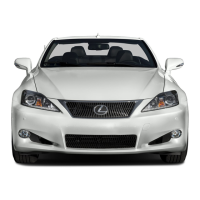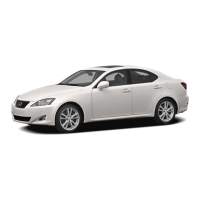
Do you have a question about the Lexus 2013 IS250 and is the answer not in the manual?
| Brand | Lexus |
|---|---|
| Model | 2013 IS250 |
| Category | Automobile |
| Language | English |
Covers essential precautions for safe driving, including vehicle operation, seat belts, airbags, child safety, and theft deterrent systems.
Details on the engine immobilizer system, double locking, and alarm functions for vehicle security.
Explanation of warning lights and indicators on the instrument cluster and center panel.
Information on various gauges and meters, including speedometer, tachometer, and fuel gauge.
Details on the multi-information display for vehicle data, messages, and settings.
Information on viewing fuel consumption data via navigation or audio screens.
Covers pre-driving checks, driving posture, seat belts, and vehicle preparation.
Details on operating the engine switch, transmission, lights, wipers, and parking brake.
Instructions for operating headlights, fog lights, turn signals, and windshield wipers/washer.
Procedure for opening the fuel tank cap and precautions for refueling.
Explanation of systems like Cruise Control, Dynamic Radar Cruise Control, LDA, parking assist, and BSM.
Guidance for winter driving conditions and tire chain usage.
Covers basic operations of the audio system, including display buttons, controllers, and connecting devices.
Guide to customizing audio system settings like language, display, sound, and personal data.
Instructions for selecting audio sources, adjusting sound settings, and using the audio menu.
Details on operating the radio, including changing top screen modes and selecting stations.
Information on CD player operation, file compatibility, and error messages.
Instructions for connecting and using iPod, USB memory devices, and AUX port.
Guide to registering, selecting, and connecting Bluetooth® devices for audio and phone.
Details on listening to Bluetooth® audio, including status display and troubleshooting.
Instructions for using the Bluetooth® phone system, including making calls and managing contacts.
Guidance on managing contacts, call history, and messaging settings.
Information on Bluetooth® system compatibility, operation, and potential issues.
Details on using 'Information' screen, MirrorLink™, USB photo, and speech command system.
Covers automatic A/C controls, dual mode, fan speed, and airflow modes.
Details on interior lighting, including footlights, personal lights, and door handle lights.
Information on storage compartments like glove box, console box, cup holders, and trunk features.
Description of sun visors, vanity mirrors, clock, power outlet, armrest, rear sunshade, assist grips, and coat hooks.
Guidelines for cleaning and protecting the vehicle's exterior and interior.
Information on scheduled maintenance requirements and do-it-yourself maintenance precautions.
Covers DIY service precautions for engine oil, coolant, tires, fuses, and bulbs.
Covers emergency flashers and procedures for stopping the vehicle in an emergency.
Guidance for towing, dealing with unusual symptoms, warning lights, flat tires, and battery issues.
Lists vehicle dimensions, weights, engine, fuel, lubrication, brakes, steering, tires, and wheels specifications.
Details on customizable features like door locks, smart entry, mirrors, and interior lighting.
Information on system initialization, such as tire pressure warning system.












